Books
Books
in random order

Common Life
A wry, cinematic tour through multiple forms: the poem, the vignette, the play—all set in our laughably lamentable contemporary world.
In three poems, one play, and three short stories, Stéphane Bouquet's Common Life offers a lively, searching vision of contemporary life, politics, and sociality. At a moment at which the fabric of everyday social life is increasingly threatened across the globe, this book is a necessary exercise of the literary imagination: what, it asks, does it mean to inhabit the world together today? With humor and sincerity, Common Life imagines the utopias of collectivity, friendship and love that might enable hope for the present and the future.
Translated by Lindsay Turner
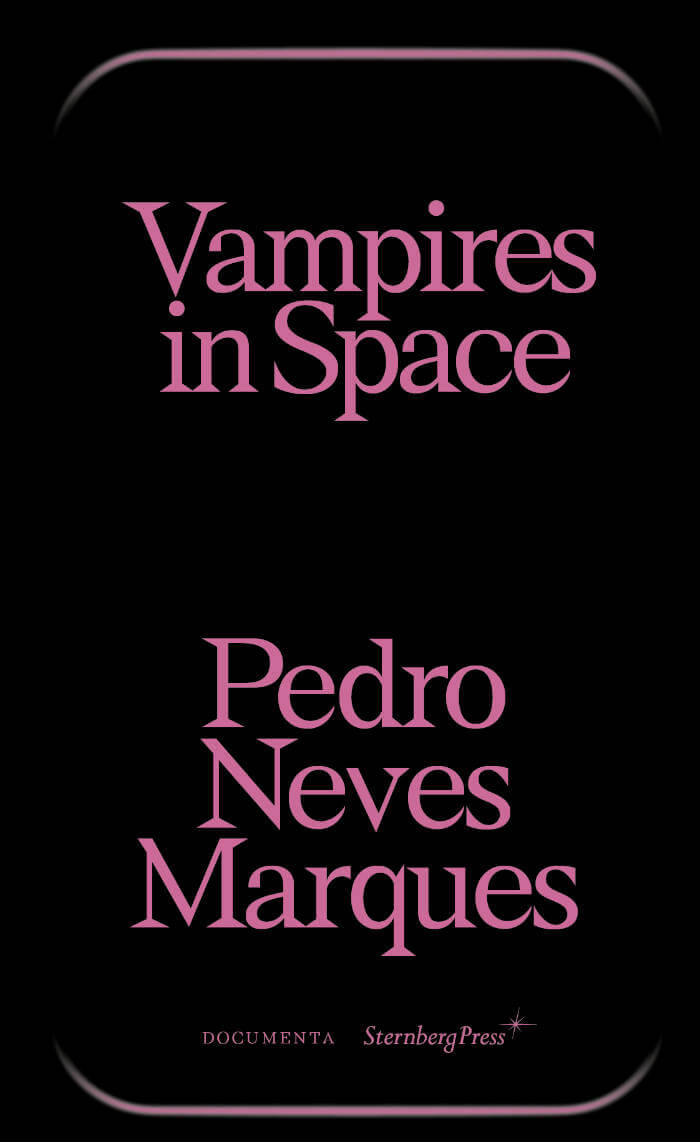
Vampires in Space
Exhibition catalogue of filmmaker, visual artist, and writer Pedro Neves Marques's solo project "Vampires in Space" at the Portuguese Pavilion, 59th International Art Exhibition – La Biennale di Venezia 2022.
"In space it's always night." A family of vampires travels through space, carrying life to a faraway planet. Alone, they recall their past, offering an open-ended narrative about the role of fiction in our lives, with a special care for transgender experiences.
This book includes an interview, film scripts and poetry by Neves Marques, curatorial texts by João Mourão, Luís Silva, alongside visual documentation and other contributions by Manuela Moscoso and Filipa Ramos.
The work of Pedro Neves Marques (born 1984 in Lisbon, Portugal) combines anthropological research, cinema, publishing, poetic and fictional writing. Their hybrid aesthetic, that blends science fiction and documentary realism is influenced by the history of feminist and queer sciences, and projects us into futures that question the control of our bodies, our desires and the world around us beyond the register of dystopia. In doing so, they explore how we might transform our imaginaries of gender, new technologies, ecology and postcolonial issues.

Blank Forms #10 – Alien Roots
The tenth and final anthology from Blank Forms offers an exceptional insight into the work, working methods and thinking of the French pioneer of musique concrète and electroacoustic composition Éliane Radigue, through key texts, a wealth of archival documents (including correspondence, notes and sketches for works, concert flyers, photographs, drawings, reviews, etc.), in-depth interviews and commissioned essays.
This volume explores the early electronic work of French composer Éliane Radigue, whose radical approach to feedback, analog synthesis, and composition on tape has long evaded historical and technical interpretation. Combining key texts, newly translated primary documents, in-depth interviews, and commissioned essays, this compendium interrogates the composer's idiosyncratic compositional practice, which both embraces and confounds the iterative nature of magnetic tape, the subtleties of amplification, and the very experience of listening.
Among these entries is an in-depth overview by cellist Charles Curtis, a close collaborator of Radigue's, examining the composer's earliest experiments with feedback techniques and analog synthesis, her eventual shift to composing for unamplified instruments and live performers, and her unique aesthetic configurations of time and presence. A number of detailed conversations between the composer and researchers Georges Haessig, Patrick de Haas, Ian Nagoski, and Bernard Girard provide crucial insights into her working methods at different points throughout her career. Religious studies scholar Dagmar Schwerk reflects upon Radigue's profound 1988 synthesizer work, Kyema, in the context of Tibetan Buddhist thought and its history, while texts by musicians Daniel Silliman and Madison Greenstone examine, in notably different ways, the technical characteristics of Radigue's sound practice. Sketches for unrealized work, contemporary reviews, concert programs, and other ephemera mapping the performance history of Radigue's early work are presented together for the first time. The anthology concludes with a roundtable discussion between Curtis, Greenstone and Anthony Vine, untangling the knot of paradoxes at the center of Radigue's artistic practice to trace the thread of her continued "ethos of resistance."
Edited by Lawrence Kumpf and Charles Curtis.
Texts by Éliane Radigue, Charles Curtis, Georges Haessig, Patrick de Haas, Ian Nagoski, Bernard Girard, Dagmar Schwerk, Daniel Sillman, Madison Greenstone, Anthony Vine.
Blank Forms' journal brings together a combination of never-before published, lost, and new materials that supplement Blank Forms' live programs. It is envisioned as a platform for critical reflection and extended dialogue between scholars, artists, and other figures working within the world of experimental music and art.
Éliane Radigue (born 1932 in Paris) is considered one of the most innovative and influential contemporary composers, from her early electronic music through to her acoustic work of the last fifteen years. Influenced by musique concrète and shaped by regular sojourns in the United States, where she discovered analogue synthesisers, her work unfolds an intensity which is at once subtle and monumental. Through her deep reflections on sound and listening, not only her music but also her working methods have come to shape a widely resonating set of new parameters for working with sound as musical material.

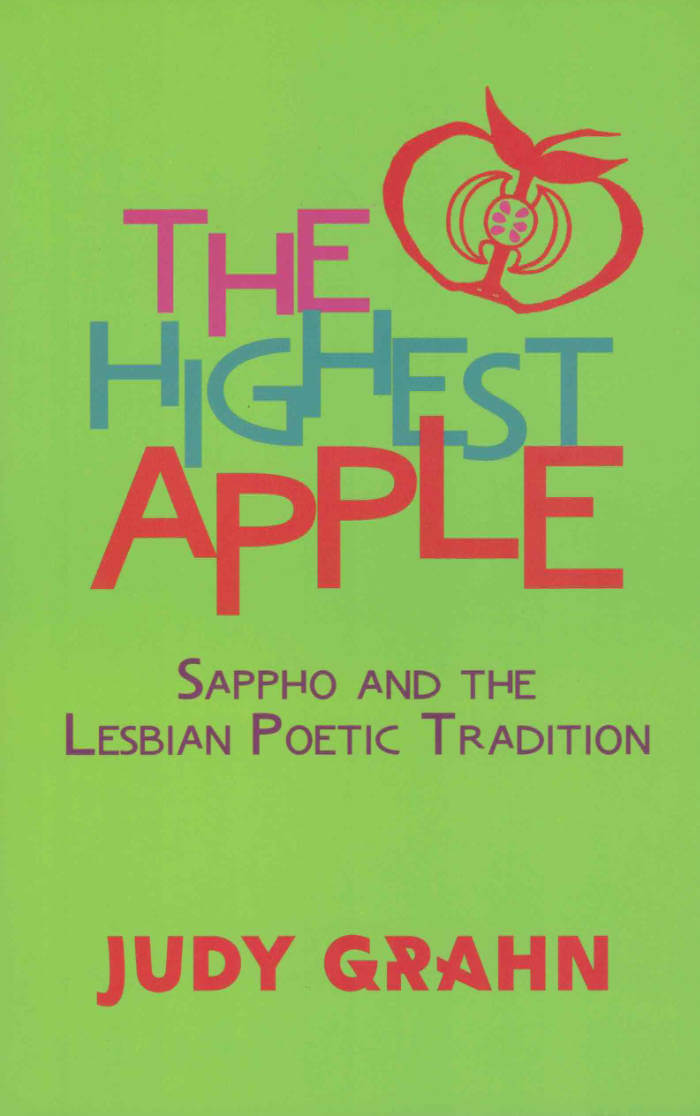
The Highest Apple: Sappho and the Lesbian Poetic Tradition
In 1985, Judy Grahn boldly declared that lesbians have a poetic tradition and mapped it from Sappho to the present day in the groundbreaking book, The Highest Apple. In this new and updated edition of The Highest Apple: Sappho and the Lesbian Poetic Tradition, Grahn revisits the original text with her characteristic ferocious intellect, passion for historical research, careful close readings, and dynamic storytelling. Grahn situates poetry by Sappho, Emily Dickinson, Amy Lowell, H.D., Gertrude Stein, Adrienne Rich Paula Gunn Allen, Audre Lorde, Pat Parker, and Olga Broumas as central to lesbian culture—and more radically as central to society as a whole.
This new edition of The Highest Apple: Sappho and the Lesbian Poetic Tradition includes Grahn’s in depth analysis of poetic work by her friend and comrade Pat Parker and suggests a transactional approach to poetry as uncovering layers of the self. Grahn assembled this text in conversation with two younger lesbian poets, Alicia Mountain and Alyse Knorr, demonstrating the continued relevance and dynamism of The Highest Apple for contemporary readers. A new introduction by Grahn, a foreword by Alyse Knorr, and editor notes by Alicia Mountain along with six responses by contemporary poets Donika Kelly, Kim Shuck, Serena Chopra, Zoe Tuck, Saretta Morgan, and Khadijah Queen highlight the on-going significance of The Highest Apple to readers, writers, and thinkers.

Pour des écoles d'art féministes !
Nelly Catheland, Adèle Bornais and 1 more
A collective manifesto for feminist art schools.
Bringing a series of intersectional feminist lectures, interviews, workshops and discussion groups back to an art school is crucial to sharing tools for emancipation and challenging the implicit criteria that structure our views and practices (identification with Western visual norms, romantic-capitalist representations of the artist-author, etc.). It is vital to give a voice to artists and those who support them in the ways in which they deal with, and even elude, relations of power.
The primary aim of this book is to share the content hosted and produced at the École Supérieure d'Art de Clermont Métropole between 2017 and 2022. It is also an opportunity to work with a group of students, artists and researchers, to think about how invitations and the production of the book can be drawn up collectively; it is a tool for collective and ideally horizontal pedagogical work within a hierarchical and hierarchizing institution. The invitations, transcription and editing of the texts were done jointly.
Edited by Lilith Bodineau, Adèle Bornais, Nelly Catheland, Charlotte Durand, Martha Fely, Lola Fontanié, Eulalie Gornes, Chloé Grard, Sophie Lapalu, Eden Lebegue, Michèle Martel, Sarah Netter, Clémentine Palluy, Mauve Perolari, Simon Pastoors, Rune Segaut, Danaé Seigneur.
Texts by Nino André & Vinciane Mandrin, Rachele Borghi, Tadeo Cervantes, Adiaratou Diarrassouba, Kaoutar Harchi, T*Félixe Kazi-Tani, Nassira Hedjerassi, Gærald Kurdian, H.Alix Sanyas, Sophie Orlando, Émilie Renard, Liv Schulman, Danaé Seigneur, Pau Simon.

mnemotope issue 003
This thrid edition of mnemotope magazine features pieces from contributors that range from playlist, recipes to poetic essays to drawings to private messages to a screenplay and beyond.
Mnemotope is a community magazine, published by bog bodies press. Mnemotope magazine takes this as its inspiration-it acts as a place in which lots of stories from across timelines and borders can sit together, and cultural memories can interact. It exists to create and hold the expression and knowledge of its diverse community, because of this, the contents of the magazine are wonderfully varied; some confessional poetry, some hastily notated recipes, some fiction, some history, lots of other things, all submitted during an open call. The format put spreads together of contributions that seem to somehow be in dialogue with one another.
The name of the magazine comes from a term that's used in writings about archaeological finds - it's a little complex when we speak about it abstractly, so take, for example, a bog body. A bog body is an object, but when we look at one it takes on another function as an image. This image is the part beyond the physicality of the object-it's what makes us think about what the world must have been like when this person was walking on it, what they looked like, what they did, who found them, how much the area they were found in must have changed and so on and so on and so on. A mnemotope is something that compresses time, and allows you to be in the bog two thousand years ago and in the museum looking at the body and at home reading about it all at once.
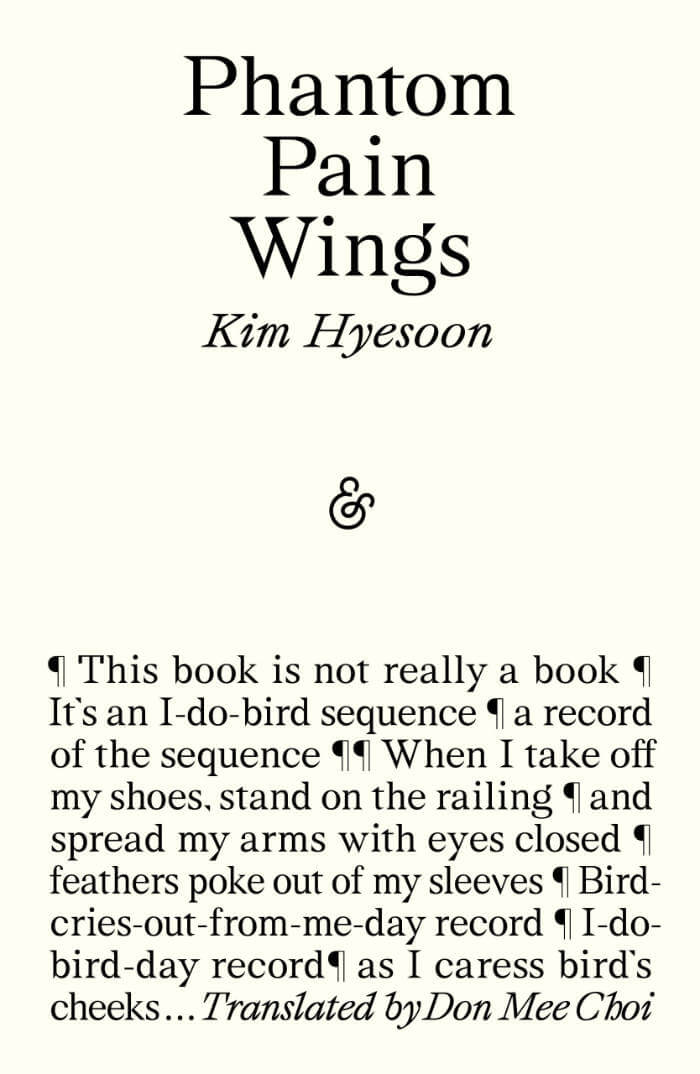
Phantom Pain Wings
Kim Hyesoon is an iconic figure in feminist poetry. In her new collection, she depicts the memory of war trauma and the collective grief of parting through what she calls an ‘I-do-bird-sequence’. Through intensely rhythmic lines marked by visual puns and words that crash together and then fly away as one, Kim mixes traditional folklore and mythology with contemporary psychodramatic realities as she taps into a cremation ceremony, the legacies of Rimbaud and Yi Sang, a film by Agnès Varda, Francis Bacon’s portrait of Pope Innocent X, cyclones, a princess trapped in a hospital, and more. A simultaneity of voices and identities rises and falls, existing and exiting on their delayed wings of pain.
Winner of the 2024 National Book Critics Circle Award for Poetry (USA)
2024 Poetry Book Society Translation Choice

Not a Force of Nature
If capital makes life a seething, complex nightmare for most people on the planet's surface, if "words do cleave the producer from the land," then what does all this dispossession feel like? Amy De'Ath turns poetry into a hot, potent, and highly funny form of criticism, in which social force is felt intimately, and voiced in the acid niceness of a work email. Amy's poems move like pieces of machinery in a cognitive amusement park, which spit you a thousand feet into the air but keep your viewpoint fixed on the same spot as before—what's different? "Land in Saskatchewan, land in Delhi," or "everything…that you want from women and gays." Not a Force of Nature makes me want to change everything. "Behold me I'm you now," Amy writes—we should be so lucky, to be thus transformed. — Kay Gabriel
Not a Force of Nature's expertly crafted poems explore the catastrophe we live among and speak through. They form a sort of feminist manifesto addressed to all forms of resistance. But also: here are love sonnets! This book is angrily precise and always a lot of fun. "No, you're a Canadianist!" — Kevin Davies
Not a Force of Nature is the kind of book that becomes possible only after rejecting the "we" evoked so often in contemporary literary culture—sometimes said to need poetry now more than ever, sometimes called community. Amy De'Ath's motley vision of solidarity, of "actual emboldened people," is way weirder, more lively, and possible. Nor do these poems content themselves, like the ghost of Marxist theory past, with pointing towards the contradictions that surround them. Do you remember email? Sonnets? Not a Force of Nature is like that, thrashing inside generic forms and always coming next: after the tendency of the rate of profit to fall, after Jane's abortion service, after the 1970s, 80s, and 90s, after Creeley, after Raworth, after Mayer, after the Xenofeminist Manifesto, after Pluto enters Aquarius. "There are still tactics like this roaming free," De'Ath writes. There are still these fervent lyric parries. Be with Not a Force of Nature now. — Stephanie Young
Through slips of verbal acuity, Amy De'Ath scrapes her way out of determinism to a world "made by hands," where our material relations are ours to make and break. History is long and history is short. History is translucent. De'Ath presents the Ferris wheel of capitalist production, where the subject lives once as worker, twice as commodity. Here, in these "concrete trousers," is a "totally liberated" working class poem turning everything into nothing as praxis. — Anahita Jamali Rad
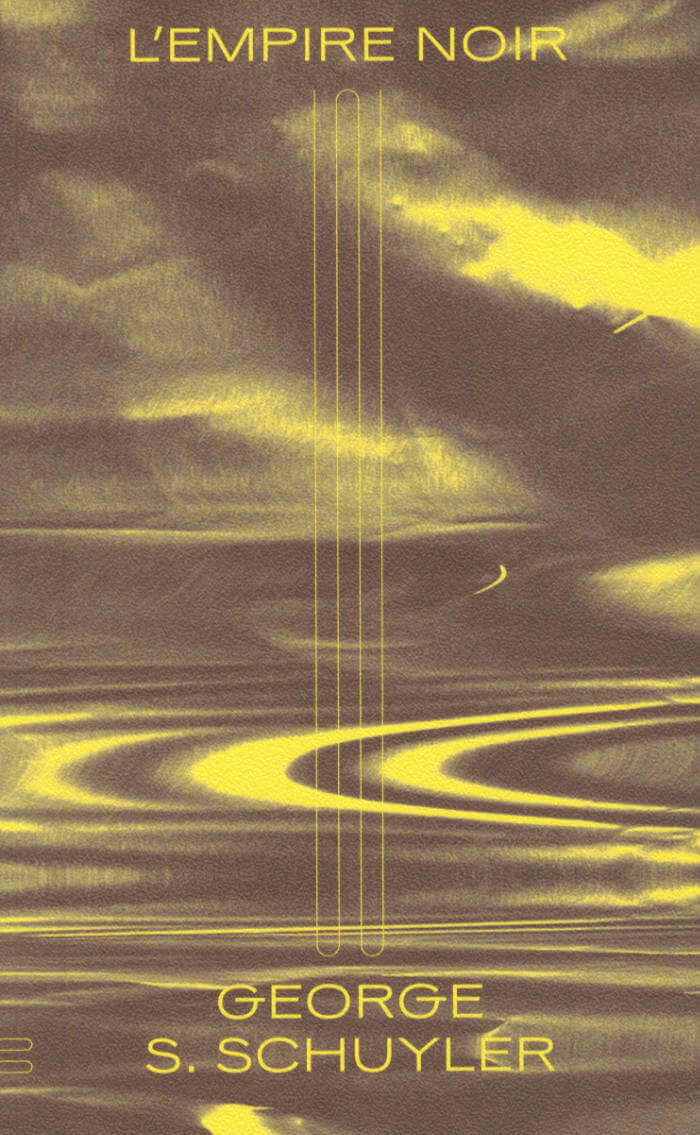
L'Empire Noir
Après une campagne militaire fulgurante, l’organisation secrète du redoutable Dr Belsidus a chassé les puissances occupantes du sol africain et s’est rendue maitre de l’ensemble du continent, unifié pour la première fois en un gigantesque empire. L’expansion a démarré et l’édification d’une civilisation d’un genre inédit est en marche. Mais les nations européennes, après s’être fait la guerre, s’apprêtent à revenir. Une course s’engage entre l’Internationale noire et les appétits impérialistes : sabotages, espionnage, guerre technologique ou bactériologique, les héros et héroïnes de L’Internationale noire né reculeront devant rien pour sauvegarder cette indépendance acquise de haute lutte.
Dans ce second volet du roman-feuilleton qui fit la réputation de G. Schuyler, retrouvez les nouvelles aventures de nos personnages, dorénavant contraints à une lutte géopolitique d’une ampleur inégalée, pour garantir à leur Empire noir un avenir radieux !
George Samuel Schuyler, 1895–1977, fut un essayiste, journaliste et romancier de première importance dans le monde culturel africain-américain de l’entre-deux-guerres. Il reste connu pour la férocité de ses critiques. Il est l’auteur d’un seul roman, Black No More, traduit en France en 2016 et d’un essai romancé dénonçant la traite au Liberia, produit de son enquête de terrain dans le pays. Proche des courants socialistes jusqu’à la Seconde Guerre mondiale, il prendra un virage nettement réactionnaire par la suite, tout en demeurant dans les mémoires de toute une génération d’écrivains, tels qu’Ishmael Reed ou Samuel Delany.

Child's Replay
Child’s Replay is a hallucinatory homecoming. As we follow THE CHILD in a series of private re-enactments, the present self is revealed as the past’s fragile construction. Pursuing the banality of trauma, a first-person character juxtaposes childhood events with internal misrepresentations, reflections on the emotional toll of migration, psychoanalytic theory, Brazilian history, and literary criticism. An exploration of the impact that language and fiction have on real bodies, Child’s Replay assembles a hybrid portrait of memory and anti-memory.
This publication is limited to 100 copies, which are signed and numbered by the author.

Switched On – The Dawn of Electronic Sound by Latin American Women
Luis Alvarado, Alejandra Cárdenas
The first book dedicated exclusively to the female protagonists of Latin American electronic music.
The book has been edited by independent curator, researcher and label head of Buh Records, Luis Alvarado, and experimental musician, multimedia artist and researcher Alejandra Cárdenas (also known as Ale Hop).
Composers and sound artists featured in this historical account include: Alicia Urreta, Beatriz Ferreyra, Elsa Justel, Eulalia Bernard, Graciela Castillo, Hilda Dianda, Ileana Pérez Velázquez, Irina Escalante Chernova, Iris Sangüesa, Jacqueline Nova, Jocy de Oliveira, Leni Alexander, Margarita Paksa, Marietta Veulens, Mónica O'Reilly Viamontes, Nelly Moretto, Oksana Linde, Patricia Belli, Renée Pietrafesa Bonnet, Rocío Sanz Quirós, Teresa Burga, Vania Dantas Leite, among others.
The official history of 20th-century avant-garde electronic music has been predominantly narrated from the point of view of Anglo-American and Western European experiences and largely remained focused on its male protagonists. To destabilize this history, this editorial project presents a collection of perspectives, essays, interviews, archival photos, and work reviews centered on the early electronic music production by Latin American female creators, who were active from the 1960s to the 1980s. The book also brings us closer to the work of a new generation of researchers who have focused on offering a non-canonical reading of the history of music and technology in Latin America. The publication is the record of a new vision, an account of the condition of being a woman in the field of music technology at a time when this was a predominantly masculine domain. The decision to take electronic technologies for sound creation as the backbone of this history is related to the intention of broadening our focus of interest outside the spectrum of institutional electroacoustic music to include other experimental, interdisciplinary and sonic arts practices involving new technologies, beyond the circuits of academic avant-garde music.
The texts that make up this publication are organized spatially and conceptually, rather than following a chronology. The selection of female composers profiled sheds light on a variety of relevant aspects: key musical contexts, experiments with technologies (such as tape, electronic synthesis, the first commercial synthesizers), diverse formats (i.e., radio art, electroacoustic pieces, installation, multimedia, theater, film, etc.), intertwined with themes, such as migration, memory, identity, collaboration, interdisciplinarity, social engagement, the acceptance of electronic music, etc. Moreover, the framework of this editorial project opened a space for intergenerational dialogue and a meeting of aesthetics, as many of the authors gathered as collaborators are composers and sound artists themselves.

Witches, Midwives, & Nurses: A History of Women Healers
Barbara Ehrenreich, Deirdre English
Witches, Midwives, and Nurses examines how women-led healing was delegitimized to make way for patriarchy, capitalism, and the emerging medical industry.
As we watch another agonizing attempt to shift the future of healthcare in the United States, we are reminded of the longevity of this crisis, and how firmly entrenched we are in a system that doesn't work.
First published by the Feminist Press in 1973, Witches, Midwives, and Nurses is an essential book about the corruption of the medical establishment and its historic roots in witch hunters. In this new and updated edition, Barbara Ehrenreich and Deirdre English delve into the current fascination with and controversies about witches, exposing our fears and fantasies. They build on their classic exposé on the demonization of women healers and the political and economic monopolization of medicine. This quick history brings us up-to-date, exploring today's changing attitudes toward childbirth, alternative medicine, and modern-day witches.

Honey Volume 2
Mars Dietz, Opashona Ghosh and 1 more
HONEY is a zine meditating on the experiences of friendship.
Volume 2 was edited by Mars Dietz, Opashona Ghosh and Dylan Spencer-Davidson—each inviting contributions from friends.
Following vol. 1’s optimism about the underappreciated potentials of friendship, vol. 2 marks a noticeable turn towards friendship's messier sides. Letters to deceased friends, childhood social complexities, unrealised sexual desire, pushback against the overfetishisation of queer kinship, and more.
Contributions from Azul De Monte, Ana Božičević, D Mortimer, Adriana Disman, Pelumi Adejumo, Iggy Robinson, Clay AD, To Doan, Edward Herring, marum, Lou Drago, Aisha Mirza, Iga Świeściak, Roya Amirsoleymani, George Lynch, Emily Pope and Kari Rosenfeld.
Original artworks by Opashona Ghosh and Iga Świeściak, and featuring artworks by Azul De Monte and Emily Pope.
Riso printed on recycled paper with Pagemasters (London).

Les Matières de la nuit
« Et ensuite quand le calme est revenu, plantez à la place une femme noire qui lève le poing, même un instant, comme pour faire semblant. Une femme noire fera le job, avec le poing levé, c’est mieux, c’est cool. » Écho ou fantôme de Suites décoloniales, ce recueil de poésie prolonge et complète les chemins parcourus par Olivier Marboeuf dans son essai, au moyen de ce que l’auteur appelle une « pratique théorique de la poésie ».
Fragments de mauvaises rencontres, haïkus sur le beat accéléré d’un train, hommages à la banlieue chérie, Olivier Marboeuf se fait conteur polyphonique, poreux au monde et dépositaire des histoires étendues et vues dans de multiples nuits.

Les Metamorpheauxses
Publié en 2025 dans le cadre du projet d'art public The River as Habitat installé dans le Lycée Edward Steichen, Clervaux et commandité par l'administration des bâtiments publics, Luxembourg.

The Queer Art of Failure
The Queer Art of Failure is about finding alternatives—to conventional understandings of success in a heteronormative, capitalist society; to academic disciplines that confirm what is already known according to approved methods of knowing; and to cultural criticism that claims to break new ground but cleaves to conventional archives.
Jack Halberstam proposes “low theory” as a mode of thinking and writing that operates at many different levels at once. Low theory is derived from eccentric archives. It runs the risk of not being taken seriously. It entails a willingness to fail and to lose one’s way, to pursue difficult questions about complicity, and to find counterintuitive forms of resistance.
Tacking back and forth between high theory and low theory, high culture and low culture, Halberstam looks for the unexpected and subversive in popular culture, avant-garde performance, and queer art. Halberstam pays particular attention to animated children’s films, revealing narratives filled with unexpected encounters between the childish, the transformative, and the queer. Failure sometimes offers more creative, cooperative, and surprising ways of being in the world, even as it forces us to face the dark side of life, love, and libido.

Love Belongs to Those Who Do the Feeling: New & Selected Poems (1966-2006)
An exciting collection of new and selected poetry by Judy Grahn. The book contains selections from Judy's entire body of poetic work from The Work of a Common Woman, The Queen of Wands and The Queen of Swords, to new poems written between 1997 and 2008.
Judy's poetry is rangy and provocative. It has been written at the heart of so many of the important social movements of the last forty years that the proper word is foundational.
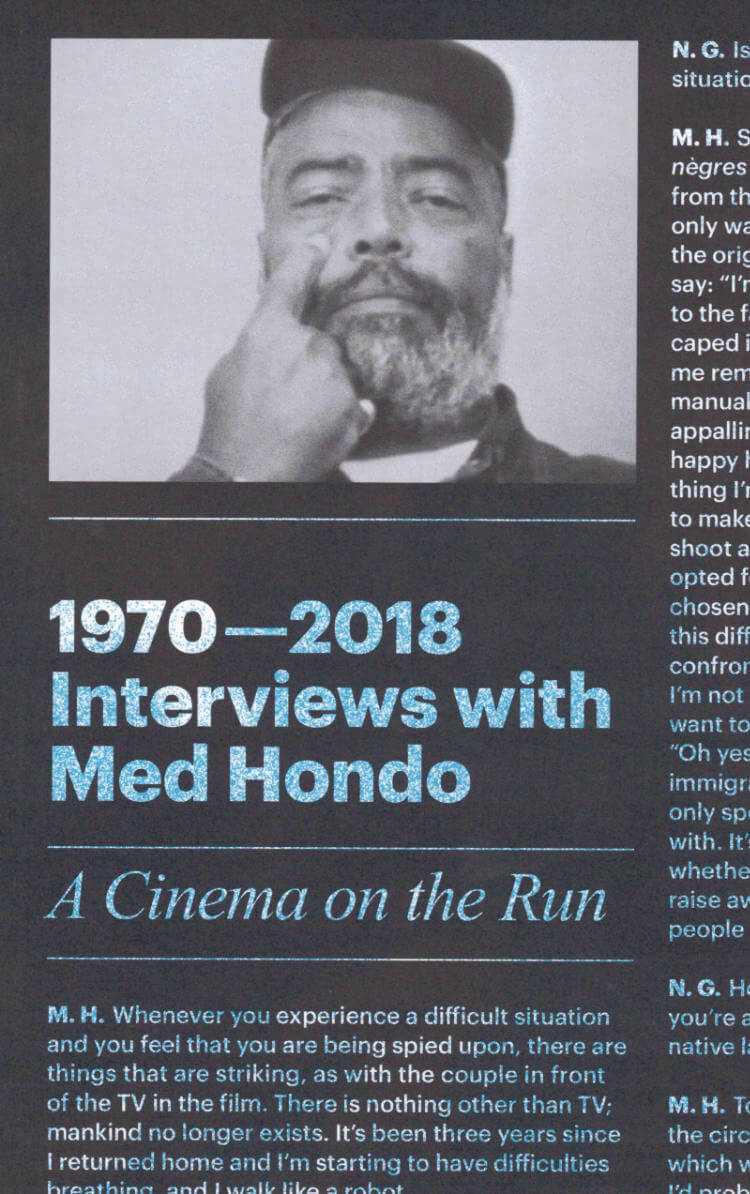
1970—2018 – Interviews with Med Hondo
Seventeen interviews conducted with Med Hondo over a period of almost half a century, most of the interviews originally published in French were translated into English.
To read Med Hondo opens us up to many perspectives: to his work and its time-historical contexts, to his interests and obsessions, to his standpoint with regard to the intertwining of politics, economics, and culture. Med Hondo describes the school of pronunciation until such point as the slightest accent is erased; he observes the insults immigrants in France have had to tolerate, and fuses their stories and histories with the present; he builds bridges to the Caribbean and to the Western Sahara, to Algeria and Burkina Faso, to Niger and Senegal, to South Africa and the USA. This publication aims to draw attention to Med Hondo's cinema and legacy.
The book originated in the long-term project Cours, cours, camarade, le vieux monde est derrière toi—Run, comrade, run, the old world is behind you—The Cinema of Med Hondo.
Franco-Mauritanian director, screenwriter, producer and actor, also known for his work in dubbing, Med Hondo (1936-2019) is one of the great figures of African cinema. His militant work denounces neo-colonialism, racism, the rupture between the peoples of Africa, immigration policies and the resulting social violence.

Devenir minéral | L’éditeur du dimanche
Echoing Jean Dubuffet's idea that thought must arise from material in artistic practice, Giuliana Prucca, through this essay, reinterprets a moment in the history of 20th-century art using materials such as stone, sand, earth, and dust. She employs the mineral to illustrate that the creative act would be a trace of the body's disappearance. The loss of humanity and the deconstruction of the subject objectify themselves in the image. In other words, art resides in the tension between representation and its loss, ultimately leaving nothing but an image.
Drawing from the influential figure of Antonin Artaud, she weaves critical and poetic connections between the texts and works of various artists, writers, and thinkers, ranging from Jean Dubuffet to Jan Fabre and Anselm Kiefer, Yves Klein and Gutaï, Joë Bousquet to Camille Bryen and Francis Ponge, Gaston Bachelard to Gilles Deleuze, and Georges Bataille to Aby Warburg.
The material is not merely a thematic pretext; it is an active and explosive catapult that questions the arbitrary linearity of a conventionally assimilated art history. Following Ponge's example, Prucca applies the principles of poetry to criticism, starting from Artaud's material, the most undisciplined of poet-artist-thinkers of the modern era. This results in a critically inventive approach dangerously suited to its object, celebrating an anti-critique. The chosen writing materials, stonepaper for the cover and recycled paper for the pages, is consistent, intending to give the impression of being covered in dust.
The essay disrupts traditional reading habits and shatters the conservatism of art criticism by inhabiting writing space differently, presenting a physically engaging interaction. This is an essay in the literal sense, an experience where form never contradicts content, urging readers to take the risk of thinking deeply and embracing a new rhythm. A complex and challenging design invites them to choose different reading options, ultimately treating criticism as one would poetry.
Giuliana Prucca [Paris | Berlin] is an independent curator, researcher, and writer. She is the founder and art director of the publishing house AVARIE, specialising in contemporary art books that explore the relationships between text and image, body and space.
Graphic design, art direction by Vito Raimondi

Reading Like a Computer
The contents of Reading Like a Computer. A Sematic Guide to Facebook's Content Moderation Policies are from leaked PowerPoint slides used to train Facebook content moderators. The contents have not been embellished or editorialized. By organizing and graphically presenting the subtle discrepancies between what Facebook allows and doesn’t allow in a post, the book highlights the contradictions and challenging logic of Facebook's community standards.

Resurgent Nahda – Arab Exhibitions in 1930s Jerusalem
The cultural and political legacies of the the 1933 and 1934 Arab Exhibitions in Jerusalem.
Resurgent Nahda examines the 1933 and 1934 Arab Exhibitions in Mandate Jerusalem, highlighting the city's role in asserting a regional Arab Nahda and fostering economic, cultural, and artistic exchange amid post-WWI geopolitical fragmentation.
The book emerges from Nadi Abusaada's seven years of research, including an award-winning 2019 essay in the Jerusalem Quarterly and two exhibitions he curated at the Khalil Sakakini Cultural Center in Ramallah (2022–2023) and Darat al-Funun in Amman (2024). Featuring six essays, an interview, and primary materials—archival documents, crafts, and artworks—the book explores Jerusalem's connections with Baghdad, Cairo, Damascus, and Beirut, tracing the journeys of artists, craftspeople, architects, and journalists who shaped this pivotal chapter in modern Arab history.
Nadi Abusaada is a Visiting Assistant Professor at the American University of Beirut. His work focuses on the material histories and visual cultures of the modern Arab world. He holds a PhD in architecture from the University of Cambridge. He has also held various academic fellowships including the ETH Zürich Postdoctoral Fellowship at ETH Zürich and the Aga Khan Postdoctoral Fellowship in Islamic Architecture at MIT. Besides his writings, Nadi Abusaada has also been involved in research-based curatorial work. He has curated and participated in a number of exhibitions around the world including in Ramallah, Amman, Zurich, Venice, Dubai, and Montreal.
Edited by Nadi Abusaada.
Texts by Nadi Abusaada, Nisa Ari, Wesam Al Asali, Samira Badran, Nadine Nour el Din, Kirsten Scheid, Sary Zananiri.

Survival Is a Promise: The Eternal Life of Audre Lorde
A bold, innovative biography that offers a new understanding of the life, work, and enduring impact of Audre Lorde.
We remember Audre Lorde as an iconic writer, a quotable teacher whose words and face grace T-shirts, nonprofit annual reports, and campus diversity center walls. But even those who are inspired by Lorde’s teachings on “the creative power of difference” may be missing something fundamental about her life and work, and what they can mean for us today.
Lorde’s understanding of survival was not simply about getting through to the other side of oppression or being resilient in the face of cancer. It was about the total stakes of what it means to be in relationship with a planet in transformation. Possibly the focus on Lorde’s quotable essays, to the neglect of her complex poems, has led us to ignore her deep engagement with the natural world, the planetary dynamics of geology, meteorology, and biology. For her, ecological images are not simply metaphors but rather literal guides to how to be of earth on earth, and how to survive―to live the ethics that a Black feminist lesbian warrior poetics demands.
In Survival Is a Promise , Alexis Pauline Gumbs, the first researcher to explore the full depths of Lorde’s manuscript archives, illuminates the eternal life of Lorde. Her life and work become more than a sound bite; they become a cosmic force, teaching us the grand contingency of life together on earth.

24 European Ethnographic Museums
With the series '24 European Ethnographic Museums' Van der Heide questions the construction and identity of the ethnographic museum today. Here, the project becomes a collection of artefacts in and upon itself and by recording the names of these institutions Van der Heide places the viewer in front of the dilemma: who is authorized to decide what is an artefact, and what should be collected and for what reason? In the 19th century, with the birth of the current European nations, museums openly referred to their colonial past. Today the museums bare more euphemistic names like: ‘Museum der Kulturen’ or ‘World Museum’ but still place the West as the self-acclaimed center of the world. The existence of the ethnographic museum, which is intertwined with the complicated and loaded colonial past, has been subject to contemporary criticism. While some of the European ethnographic institutions have attempted to come to terms with the past of their collections and their heritage, Van der Heide focuses upon how language continues to reflect the political present of the institutions.